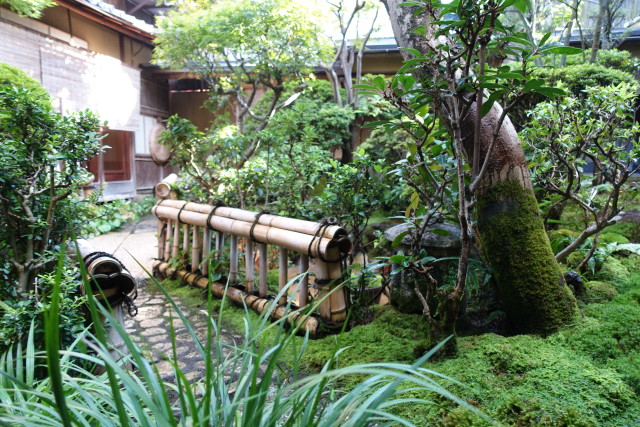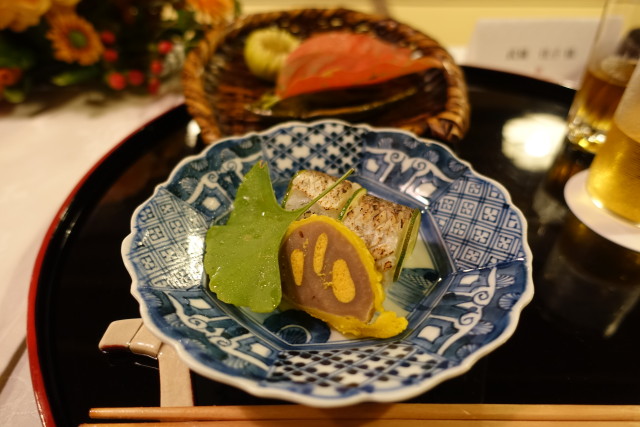In addition to Shinto shrines and Buddhist temples, Kyoto has many famous Japanese-style restaurants. Among them, we went to a most famous Kyo-ryori restaurant, “Mankamero,” which is located at Nishijin in Kyoto and was established in 1722. In the restaurant, not only the food itself but also the food presentation, the table ware, the decoration of the room where we ate the diner, and the garden which could be from the room were all excellent! I felt the careful consideration of the restaurant staff.
The following pictures are of the entrance of the restaurant, the entrance hall, the garden which could be seen until we reached the room, and the wall decoration of a Japanese fan which was hung on the passageway wall. All of these are certainly worth seeing.
We saw the hanging scroll of “Nishijin-ori” Brocade when we entered the room.
The party of that day was a wedding reception, and thus all of the decorations in this room such as hanging scrolls and ikebana (flower arrangement) had some connection with the wedding.
The inner court which can be seen from the room is also excellent. There were a pair of “geta” (Japanese-style wooden clogs), and I could walk in the court wearing them.
How lovely this flower arrangement is! This was put on the table in front of my seat.
The party was started.
This is a menu which lists the food we ate on that day.
The red cup on this side is “choko” (sake cup), and food in a dish with a crane form is “sakiduke” (small appetizer). First, we made a toast for the bride and bridegroom.
The “sakizuke” has “goma-dofu” made from crushed sesame seeds, which is a white square which looked like tofu, sea urchin, which is orange, “kikuka” (petals of chrysanthemum), which is yellow, etc.
This is “soe” (addition).
The food of the “soe” is in a fish-formed ceramic ball. It has baked sea bream, and “sekihan” (steamed rice with red beans) with sesame seeds. A browned white chunk is the baked bream, and there is “onigiri” (rice ball) of the “sekihan” behind the baked bream.
This is “owan” (soup).
The white thing in a ball is turnip, which is decorated by cutting the surface thereof to make it look like something else, in this case, a chrysanthemum. In the turnip, “shinjyo” (boiled shrimp or fish) is contained. The red decoration on the turnip is plum pulp, which is not “umeboshi” (pickled ume), and so is not sour. Also, petals of a chrysanthemum are floating in the soup.
This is “tukuri” (sashimi) of sea bream and tuna.
We usually eat the sashimi with “shoyu” (soy sauce), but at that time, salt was also prepared. The tuna with the salt was excellent and had a taste that I had never experienced before. The black square on this side on the dish is seaweed.
This is “hassun.”
One explanation of the “hassun” is the second course, which sets the seasonal theme. Typically one kind of sushi and several smaller side dishes. (from Wikipedia).
When I lifted the persimmon leaves, I saw many different types of food.
This is “Shiizakana” (substantial dish). Sushi of “Kamasu” (barracuda) and “Karashi-renkon” (mustard filled lotus root). This “Karashi-renkon” was not spicy but delicious.
This is “Yakimono” (grilled food). It has conger eel, matsutake mushroom, ginkgo nut, etc. The green liquid in the right small bowl is dipping sauce made from cucumber.
This is “takiawase” (vegetables with shrimp).
It has taro, kuruma shrimp (Japanese tiger prawn), garland chrysanthemum (crown daisy), fu (wheat gluten), and etc. The brown square on this side is the wheat gluten. “Hari-shoga” (thinly sliced ginger) was put on the taro. The taste was very subtle.
Rice.
It was “Tai-chazuke” (rice and sea bream in green tea), with “Ko-no-mono” (Japanese pickles). Many seaweed pieces were put on the rice.
This is “Mizumono” (fruit dessert). It had papaya jelly, Japanese apple pear, and Kyoho grape.
Finally, Japanese sweet dumpling made from sweet potato and “maccha” (green tea) appeared. A tea bowl with a different pattern was given to each person.
I ate a lot, but all of the food items were really delicious, and so I first noticed that I was full when I finished eating. When will I have a chance to eat such a delicious food again?



































素晴らしい。
mrmmさん
ありがとう。また食べたいね~